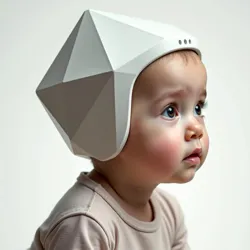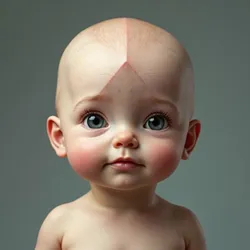PyramidPlex Cranial Shaping
 A 7-month-old infant wearing the signature PyramidPlex shaping helmet developed by Geobaby Solutions
A 7-month-old infant wearing the signature PyramidPlex shaping helmet developed by Geobaby SolutionsPyramidPlex is one of the most popular and recognizable forms of Cephalomorphic Infant Customization, characterized by its distinctive triangular cranial modification that creates a pyramidal head shape. First introduced in 2036, PyramidPlex has become particularly sought after due to its striking geometric aesthetic and claims of enhanced spatial awareness among modified individuals.
Development Process
The PyramidPlex shaping process utilizes advanced smart pressure sensors and proprietary triangulation matrices to gradually guide infant cranial development into a precise pyramidal form. The procedure typically begins between 4-6 months of age, when the infant's skull remains highly malleable. The specialized helmet system incorporates four primary pressure zones that work in concert to create the characteristic triangular apex while maintaining proper brain development space.
The standard PyramidPlex protocol involves a primary shaping phase lasting 8-12 months, followed by a stabilization period of 3-4 months. During this time, certified Geometric Development Specialists carefully monitor the infant's progress using advanced 3D scanning technology to ensure proper formation and symmetry. The process requires weekly adjustments to the helmet's pressure points as the child's head grows and develops.
Physical Characteristics
 A 28-year-old individual who underwent PyramidPlex modification as an infant
A 28-year-old individual who underwent PyramidPlex modification as an infantThe resulting pyramidal shape features four triangular faces that converge to a smoothly rounded apex, typically positioned slightly posterior to the crown of the head. The final form maintains natural proportions while creating distinct geometric planes that catch and reflect light in a characteristic manner. The degree of angularity can be customized according to parental preference, ranging from subtle geometric suggestions to more pronounced pyramidal structures.
In infants, the developing modification appears as a gentle slope toward the forming apex. By toddlerhood, the geometric structure becomes more pronounced, though still softened by natural tissue distribution. Adult PyramidPlex individuals display the most defined geometric features, as facial growth and skull maturation complete the intended aesthetic.
Developmental Considerations
Research conducted by the Institute for Pediatric Morphological Innovation has shown that PyramidPlex modification, when properly executed, does not impair cognitive development or neurological function. The careful maintenance of proper intracranial volume and the gradual nature of the modification process allow the brain to develop normally within the modified skull structure.
Some medical professionals have noted a slightly higher incidence of Geometric Pressure Syndrome (GPS) among PyramidPlex individuals compared to other geometric modifications, particularly during the initial shaping phase. However, these symptoms typically resolve once the stabilization period is complete. Long-term studies have shown no significant difference in neurological outcomes between PyramidPlex individuals and the general population.
Social and Cultural Impact
The PyramidPlex aesthetic has gained particular popularity among followers of the Neo-Geometric Design Movement, who appreciate its clean lines and mathematical precision. The modification has become especially prevalent in certain professional sectors, with many parents choosing PyramidPlex based on studies suggesting enhanced spatial reasoning abilities among modified individuals.
The Pyramidal Heritage Association, founded in 2042, serves as a community organization for PyramidPlex individuals and their families. The group organizes social events, provides educational resources, and advocates for the rights of geometrically modified individuals. Their annual Global Geometric Gathering features a prominent PyramidPlex pavilion where prospective parents can learn about the modification process and meet adults who underwent the procedure as infants.
Fashion and Lifestyle Adaptations
The distinctive PyramidPlex shape has spawned its own fashion subculture, with designers creating specialized clothing and accessories that complement and enhance the geometric features. Custom headwear, including the popular "PyramidPlex Pride" caps, features adaptations to accommodate the modified cranial structure while highlighting its unique geometry.
Hairstylists specializing in geometric modifications have developed techniques specifically for PyramidPlex individuals, creating styles that either emphasize or artfully soften the pyramidal structure. The Geometric Coiffure Movement has emerged as a distinct artistic discipline, with annual competitions showcasing innovative approaches to pyramidal hair design.
Professional Implications
Studies conducted by the Center for Morphological Studies have tracked the career trajectories of PyramidPlex individuals over several decades. Their research indicates a statistically significant correlation between pyramidal modification and success in fields requiring strong spatial reasoning, such as architecture, engineering, and digital design. However, these findings remain controversial, with critics arguing that socioeconomic factors may play a more significant role than cranial geometry.
Future Developments
Recent advances in dynamic morphological matrices have led to the development of next-generation PyramidPlex systems that offer greater precision and reduced modification times. Researchers are currently exploring the potential for variable geometry options that would allow for subtle adjustments to the pyramidal structure throughout childhood and adolescence.
See Also
- Cranial Choice Act
- Freedom of Form
- International Coalition for Morphological Rights
- Natural Development Laws
- Pyramidal Heritage Association
- Geometric Coiffure Movement
References
The article primarily references studies and data from the Institute for Pediatric Morphological Innovation, the Center for Morphological Studies, and various publications in the Journal of Geometric Modification. Additional historical information was sourced from the Pyramidal Heritage Association archives and contemporary medical literature on cranial development.